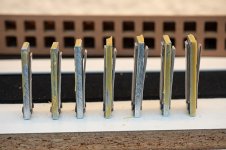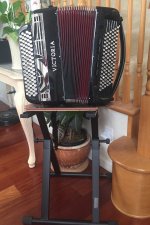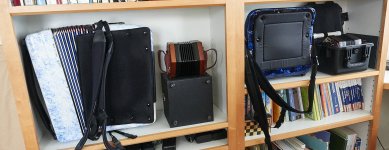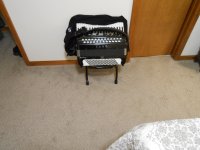When you’re not playing your ? where do you keep it/them?
-
-
We're having a little contest, running until 15th May. Please feel free to enter - see the thread in the "I Did That" section of the forum. Don't be shy, have a go!
You are using an out of date browser. It may not display this or other websites correctly.
You should upgrade or use an alternative browser.
You should upgrade or use an alternative browser.
Where do you keep your accordion?
- Thread starter knobby
- Start date
I have a room full of sundry musical instruments. Some of them in cases. Many on display.When you’re not playing your ? where do you keep it/them?
Dingo40
Been here for ages!
I keep mine in their cases, lying flat on their backs, on top of the wardrobes in the bedrooms,
Getting them up there is my "gym " session for the day: a kind of weight lifting "snatch and press" or "snatch and lift"!?
Each case rests on a suitably sized thick carpet mat which allows me easily to slide the accordion in its box to its final position.
This has worked well for decades ?
Getting them up there is my "gym " session for the day: a kind of weight lifting "snatch and press" or "snatch and lift"!?
Each case rests on a suitably sized thick carpet mat which allows me easily to slide the accordion in its box to its final position.
This has worked well for decades ?
Last edited:
This is a really bad idea! An accordion that has cassotto or Winkelbaß should always be stored in the playing position and other accordions can be stored on their feet. But no accordion should be stored laying "flat". You should always store an accordion in a way that none of the valves can be pulled open by gravity. You won't notice any bad consequences after a short while, but after 10 or maybe 20 years you will notice the effect of gravity! Some valves will no longer close without additional force, causing a "plop" sound (of the valve being sucked closed) when a note starts.I keep mine in their cases, lying flat on their sides, on top of the wardrobes in the bedrooms,
Getting them up there is my "gym " session for the day: a kind of weight lifting "snatch and press" or "snatch and lift"!?
Each case rests on a suitably sized thick carpet mat which allows me easily to slide the accordion in its box to its final position.
This has worked well for decades ?
one in the living room in the backpack, the rest in the attic
fphlpsnrg
contributing member
Doom and gloom from one of the two people whose opinion I trust on this forum. Step 2 in putting the instrument away for the night will now be setting the case so that the instrument is in its playing position. My primary concern had been for a tree limb crashing through the roof during one of our violent storms.This is a really bad idea! An accordion that has cassotto or Winkelbaß should always be stored in the playing position and other accordions can be stored on their feet. But no accordion should be stored laying "flat". You should always store an accordion in a way that none of the valves can be pulled open by gravity. You won't notice any bad consequences after a short while, but after 10 or maybe 20 years you will notice the effect of gravity! Some valves will no longer close without additional force, causing a "plop" sound (of the valve being sucked closed) when a note starts.
Not just "doom and gloom" and not just an academic argument:Doom and gloom from one of the two people whose opinion I trust on this forum. Step 2 in putting the instrument away for the night will now be setting the case so that the instrument is in its playing position. My primary concern had been for a tree limb crashing through the roof during one of our violent storms.

These are the lowest 7 notes in the M register in cassotto of an accordion that (when not being played) was always stored on its feet for about 10 years. The valves being pulled down by gravity stayed open even in the playing position. These notes (on pull) were all slow to start because the air pressure first had to suck the valves closed before the note (next to these valves) would start. I have seen this several times by now. We always store our own accordions in the the playing orientation and never had this problem.
This problem occurs mostly with 1) large leather valves that have plastic boosters and 2) smaller leather valves that have no boosters.
JeffJetton
Prolific poster
I have five working accordions and a small house. So they're basically stashed all over the place--anywhere there's enough space!
- Joined
- May 7, 2013
- Messages
- 429
- Reaction score
- 145
I have a few amp stands. This is one of them:

Another one is an AMS-BS-625; the top is for an FR-7b, the bottom sometimes holds an FR-1xb.
Two others acoustic accordions. The one on the right has no cassotto.

All the cases are in the attic until (rarely) needed.

Another one is an AMS-BS-625; the top is for an FR-7b, the bottom sometimes holds an FR-1xb.
Two others acoustic accordions. The one on the right has no cassotto.

All the cases are in the attic until (rarely) needed.
Last edited:
embers
Member
Kept in my bedroom, which is also where I practice. No room in a very tiny closet, and only one wall has empty floor space. So I purchased an angled accordion stand. Having a really dusty house, I cover the accordion with a clean, older knit shirt. Based on above chats, I didn't know it could be an issue to store one on its feet or upright. Mine has cassotto so it looks like I'm keeping mine incorrectly? That's an ouch to find out.


Last edited:
Dingo40
Been here for ages!
Paul's probably quite right. ? I can only report that ( not having been cautioned otherwise by either teachers or accordion technicians at the time) my several accordions have lain on their backs ever since I've acquired them ( some from new) 30 and 50 years (and who knows how long before that, in some cases) without any evident injury.
Should they last another dozen years or so, it will no longer be any of my concern!?
Just a thought: if accordions were meant to be stored in an upright, playing orientation, you'd think the manufacturers would have placed the little pods (feet) appropriately, instead of on the bass box at each end of the bass strap??
Should they last another dozen years or so, it will no longer be any of my concern!?
Just a thought: if accordions were meant to be stored in an upright, playing orientation, you'd think the manufacturers would have placed the little pods (feet) appropriately, instead of on the bass box at each end of the bass strap??
Last edited:
Chickers
Active member
debra:Not just "doom and gloom" and not just an academic argument:
These are the lowest 7 notes in the M register in cassotto of an accordion that (when not being played) was always stored on its feet for about 10 years. The valves being pulled down by gravity stayed open even in the playing position. These notes (on pull) were all slow to start because the air pressure first had to suck the valves closed before the note (next to these valves) would start. I have seen this several times by now. We always store our own accordions in the the playing orientation and never had this problem.
This problem occurs mostly with 1) large leather valves that have plastic boosters and 2) smaller leather valves that have no boosters.
That is really interesting, and very concerning regarding your suggestion on storing accordions with cassotto. It's the first I have heard this.
I was usually told an accordion is built with "feet" for a purpose, so that is the preferred position. And that is the way I usually store my accordions.
I have a Excelsior AC with Tone Chamber ---which I understand is "cassotto". A beautiful accordion that I seldom play, and I customarily store the Excelsior in it's case upright on it's feet. According to Excelsior, the accordion was built mid to late 1980's., and it's in almost new condition.
Before purchasing it, I had a local accordion-smith inspect the instrument, and he stated it was close to new in and out. Very little use.
So, if I understand you correctly, I should store this accordion in it's case, on it's "side" or playing position ? Do you recommend added padding
on that side since it will be resting on the shoulder strap hardware, etc ??
Thank you for your thoughts.
Chickers
Seven Hills, Ohio USA
Dingo40
Been here for ages!
Chickers,
I have had a Bugari Armando Champion Casotto since new . It has lain on its back in its box on top of the wardrobe ( some 32 years now), without any evident issues.
I wouldn't get too excited!??
Whenever there's more than one option, there's always a party to support each possibility ( see Gullivers Travels and the "Big Enders" and the "Little Enders" in the "which end of the breakfast egg to start on controversy!"?
My long in the tooth repairman and accordion dealer , now semi retired, had an extensive collection of accordions as his retirement fund nest egg.
From the early 1950s, all of them were stored, in their boxes: standing on their pods ( bass boards down), as were all the accordions in his showroom cabinets: literally hundreds of them in all.?
I have had a Bugari Armando Champion Casotto since new . It has lain on its back in its box on top of the wardrobe ( some 32 years now), without any evident issues.
I wouldn't get too excited!??
Whenever there's more than one option, there's always a party to support each possibility ( see Gullivers Travels and the "Big Enders" and the "Little Enders" in the "which end of the breakfast egg to start on controversy!"?
My long in the tooth repairman and accordion dealer , now semi retired, had an extensive collection of accordions as his retirement fund nest egg.
From the early 1950s, all of them were stored, in their boxes: standing on their pods ( bass boards down), as were all the accordions in his showroom cabinets: literally hundreds of them in all.?
Last edited:
- Joined
- Apr 30, 2013
- Messages
- 5,163
- Reaction score
- 937
Paul has correctly posted THE PROPER WAY to store Cassotto and Non Cassotto accordions. Reading this post I find some
answers of a doubtful nature. I learned the proper handling & storing of accordions more than a half century ago and
teach it to customers that for some reason are not aware of or not taught proper accordion strorage.
Improper storage WILL IN TIME affect the accordion valves to curl and not close properly. I find at lest 2 out of 10 Cassotto
accordions I take in have curled tone chamber valves because of improper storage. These misaligned valves take time to
show up but WILL in time curl and require replacement or repair. There are really only 2 basic & proper methods for
storage.
(1) Non Cassotto types should be stored on it's feet. Although storing it in an upright position will not harm it.
(2) Cassotto type accordions MUST BE stored in a playing position as not is just an accident waiting to happen.
For many years when purchasing a new Pro or Semi-Pro accordion the case was equipped with 2 handles and feet
on the bottom & side. The top handle for carry & the side handle for storage.
I build custom accordion cases and ALL are equipped with top handles & bottom feet also side handles & side
feet. 90% have wheels installed.
Now this only applies to acoustic accordions as the "V" types can be stored in any fashion you desire.
answers of a doubtful nature. I learned the proper handling & storing of accordions more than a half century ago and
teach it to customers that for some reason are not aware of or not taught proper accordion strorage.
Improper storage WILL IN TIME affect the accordion valves to curl and not close properly. I find at lest 2 out of 10 Cassotto
accordions I take in have curled tone chamber valves because of improper storage. These misaligned valves take time to
show up but WILL in time curl and require replacement or repair. There are really only 2 basic & proper methods for
storage.
(1) Non Cassotto types should be stored on it's feet. Although storing it in an upright position will not harm it.
(2) Cassotto type accordions MUST BE stored in a playing position as not is just an accident waiting to happen.
For many years when purchasing a new Pro or Semi-Pro accordion the case was equipped with 2 handles and feet
on the bottom & side. The top handle for carry & the side handle for storage.
I build custom accordion cases and ALL are equipped with top handles & bottom feet also side handles & side
feet. 90% have wheels installed.
Now this only applies to acoustic accordions as the "V" types can be stored in any fashion you desire.
embers
Member
Paul and Jim --- Thanks for the technical info on accordion storage. Always get to "start over" when I learn the unknown things.
Just happened to me that neither the gentleman who sold me my accordion, nor the gentleman who sold me the accordion stand (photo in post #10), said anything about storing the cassotto type in a playing position. I'm not able to set the accordion on this angled stand; doesn't fit at all. So I think my next step is to try and return the accordion stand, which I recently purchased. Then go from there.
One other question (at least for now) about the playing position storage. :*) I noticed a couple of photos above where the bellows were not locked. Is that the preferred way to store upright? I'm also interested in what answer you provide to Chickers about the accordion's protection when it stands on the bottom shoulder strap hardware. Appreciate it. ~embers
EDIT (Nov 21, 2020)
After reading about possible damage to a cassotto accordion, I tend to pursue the path of caution. Since this was posted, I have built a wooden stand to hold my Sano in the playing position. I then wrote to the shop owner where I bought the metal stand about returning it, and explained the considerations brought to our attention by Paul and Jim. Here was his response, maybe positioned somewhat on both sides of the coin:
I disagree with the techs' assessment. The accordions have feet on the bottom for the reason that they can be rested upright on the feet for daily use. It is only when an accordion is stored long term (months or years) that it is advisable to keep the accordion sideways so that the gravity will not curl the valves. This takes a long time and does not happen with regular use as the air is circulated and valves are moving regularly. The stand is designed for short term use. The accordion in the case can be stored on the side long term.
I wouldn't mind at all playing my accordion for another decade. So the "path of caution" noted by our tech experts is worth following for me.
Just happened to me that neither the gentleman who sold me my accordion, nor the gentleman who sold me the accordion stand (photo in post #10), said anything about storing the cassotto type in a playing position. I'm not able to set the accordion on this angled stand; doesn't fit at all. So I think my next step is to try and return the accordion stand, which I recently purchased. Then go from there.
One other question (at least for now) about the playing position storage. :*) I noticed a couple of photos above where the bellows were not locked. Is that the preferred way to store upright? I'm also interested in what answer you provide to Chickers about the accordion's protection when it stands on the bottom shoulder strap hardware. Appreciate it. ~embers
EDIT (Nov 21, 2020)
After reading about possible damage to a cassotto accordion, I tend to pursue the path of caution. Since this was posted, I have built a wooden stand to hold my Sano in the playing position. I then wrote to the shop owner where I bought the metal stand about returning it, and explained the considerations brought to our attention by Paul and Jim. Here was his response, maybe positioned somewhat on both sides of the coin:
I disagree with the techs' assessment. The accordions have feet on the bottom for the reason that they can be rested upright on the feet for daily use. It is only when an accordion is stored long term (months or years) that it is advisable to keep the accordion sideways so that the gravity will not curl the valves. This takes a long time and does not happen with regular use as the air is circulated and valves are moving regularly. The stand is designed for short term use. The accordion in the case can be stored on the side long term.
I wouldn't mind at all playing my accordion for another decade. So the "path of caution" noted by our tech experts is worth following for me.
Last edited:
Thanks a lot Jim! Often I find that I'm the only one advocating this storage procedure and people are just in disbelief, in part because in an accordion store all instruments on display are placed on their feet. Even storekeepers have disagreed with me. Even the Victoria factory disagreed, but in their defence they used to place (metal) boosters on all the leather valves, and then it is not much of an issue. At some point for a short while they tried the now more common leather + plastic boosters which are more efficient to install (no messing around with glue for boosters and the paper or leather dots) but they quickly abandoned these, as the plastic boosters lose their strength over time. (The picture I showed was from a Victoria form that time period.)Paul has correctly posted THE PROPER WAY to store Cassotto and Non Cassotto accordions. ...There are really only 2 basic & proper methods for
storage.
(1) Non Cassotto types should be stored on it's feet. Although storing it in an upright position will not harm it.
(2) Cassotto type accordions MUST BE stored in a playing position as not is just an accident waiting to happen.
...
It is normal for people with cassotto instruments to not notice the problem. In order to do so you need to 1) listen to what your instrument does when you play and 2) not think that the delay and plop sounds are "normal for accordions". Most people do not do either if these 2 things. They also typically think that a slight tremolo in the LM, MH or LH registers is normal, and when they hear that a few notes are out of tune it really means that at best a few notes are still in tune and all other notes are out of tune...
So folks, please keep in mind that when *you* do not believe your accordion has a problem it does not mean that it has no problem. No accordion can defy the laws of physics (gravity and material strength in this case).
Corinto
Well-known member
Before buying my first accordion I came to the forum to learn (the previous forum) and have always stored my accordions on their feet, as recommended frequently by Paul and Jim. No cassotto accordions here, just a few small HOHNERs from the 1930s (Pirol, Lucia and Cornelia I).
Two of the HOHNER LUCIAs are stored at hand in two poufs (pouffes, ottomans) in our sitting room. The MIDI LUCIA (reedless) is kept in our spare room, on a shelf for easy reach, the two PIROLs in their cases also on a shelf and the CORNELIA I and the LOGICORDEON in their gigbags in a closet in the same and sole spare room.
Again, all are kept on their feet as recommended by those whose opinion I trust. Thanks Paul and Jim, I've learned a lot here on this site with your comments! And thanks Knobby for keeping this site online!
Two of the HOHNER LUCIAs are stored at hand in two poufs (pouffes, ottomans) in our sitting room. The MIDI LUCIA (reedless) is kept in our spare room, on a shelf for easy reach, the two PIROLs in their cases also on a shelf and the CORNELIA I and the LOGICORDEON in their gigbags in a closet in the same and sole spare room.
Again, all are kept on their feet as recommended by those whose opinion I trust. Thanks Paul and Jim, I've learned a lot here on this site with your comments! And thanks Knobby for keeping this site online!
Anyanka
Prolific poster
Interesting. My (non cassotto) Pigini fits into its case in one particular orientation only (there's a cloth attached for covering the keyboard), and the case has a handle which makes it practically mandatory to store the accordion on its feet rather than in playing position.
Anyway, the Pidge lives in its case under the Dulcitone, for ease of access; the Hohner Amati lives in its case in the understairs cupboard, because it is mainly for use away from home. I don't leave the accordions out in the open as we have an extremely dusty and hairy house (six greyhounds and a lurcher).
Anyway, the Pidge lives in its case under the Dulcitone, for ease of access; the Hohner Amati lives in its case in the understairs cupboard, because it is mainly for use away from home. I don't leave the accordions out in the open as we have an extremely dusty and hairy house (six greyhounds and a lurcher).
I tend to keep one PA and one CBA out so that I can easily get to them. If they were in their cases, I would only pick them up when I was planning a longer practice session. When they are out, I tend to grab them and play a few songs when I pass by, or if the family is getting ready to go out and I am waiting for them to get ready. My collection grows and shinks, so if I often times have one or two sitting in their cases and stored away. I also take the straps off when they are in the cases, so they don't get scratched.
I store mine on their feet. None of them are cassotto.
I store mine on their feet. None of them are cassotto.
Similar threads
- Replies
- 2
- Views
- 89
- Replies
- 29
- Views
- 855
